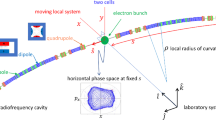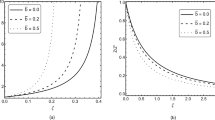Conclusions
In a gyrotron (amplifier or oscillator) having an electrodynamic system in the form of a slightly irregular waveguide having a low effective Q, the frequency of the variable field is close to the critical frequency of one of the natural waves of the waveguide in operating modes having a high efficiency; as consequence of this:
-
1)
a fairly accurate determination of the optimal parameters of the system may be accomplished by extrapolation of the results of the theory based on the fixed-variable-field-structure approximation;
-
2)
a constraint on the output power exists which is caused on the one hand by mode competition and on the other hand by rebunching of electrons in an excessively powerful variable field, which according to the constraint imposed by the diffraction Q(1), may develop in the electrodynamic system of a gyrotron when a powerful electron beam is injected into it.
Although the indicated constraints are of a universal character, it is obvious that by choosing the profile of the electrodynamic system and the distribution of the static magnetic field one may achieve a noticeable increase in efficiency, power, and likewise a widening of the electronic frequency tuning range or the amplification passband of the gyrotrons in comparison with the simplest versions of this type of device.
Similar content being viewed by others
Literature Cited
A. V. Gaponov, M. I. Petelin, and V. K. Yulpatov, Izv. VUZ, Radiofiz.,10, Nos. 9–10, 1414 (1967).
M. A. Moiseev and M. I. Petelin, Report to the Conference “Electronic Devices and Their Fields of Application” [in Russian], Tomsk (1972).
V. L. Bratman, Izv. VUZ, Radiofiz. (in press).
S. N. Vlasov, G. M. Zhislin, I. M. Orlova, M. I. Petelin, and G. G. Rogacheva, Izv. VUZ, Radiofiz.,12, No. 8, 1236 (1969).
M. A. Moiseev, G. G. Rogacheva, and V. K. Yulpatov, Annotations and Abstracts of Reports to the XXIVth All-Union Scientific Session of the A. S. Popov Scientific-Technical Radio-Engineering, Electronic, and Communication Society [in Russian], Moscow (1968).
B. Z. Katsenelenbaum, Theory of Irregular Waveguides Having Slowly Varying Parameters [in Russian], Izd AN SSSR, Moscow (1961).
A. V. Gaponov. A. L. Gol'denberg, D. P. Grigor'ev, N. F. Kovalev, T. B. Pankratova, M. I. Petelin, and V. A., Flyagin, Izv. VUZ, Radiofiz. (in press).
V. E. Shamanskii, Methods for Numerical Solution of Boundary Value Problems on Electronic Computers [in Russian], Naukova Dumka, Kiev (1966).
G. S. Nusinovich and R. É. Érm. Élektronnaya. Tekhnika, Ser. 1, Élektronika SVCh, No. 8, 55 (1972).
S. I. Vyrovoi and G. N. Rapoport (in press).
I. S. Kovalev, A. A. Kuraev, E. M. Demidovich, and F. G. Shevchenko, Dokl. Akad. Nauk BSSR,16, No. 1, 24 (1972).
M. A. Moiseev and G. S. Nusinovich, Izv. VUZ, Radiofiz. (in press).
Additional information
Scientific-Research Radio-Physics Institute. Translated from Izvestiya Vysshikh Uchebnykh Zavedenil, Radiofizika, Vol. 16, No. 4, pp. 622–630, April, 1973.
Rights and permissions
About this article
Cite this article
Bratman, V.L., Moiseev, M.A., Petelin, M.I. et al. Theory of gyrotrons with a nonfixed structure of the high-frequency field. Radiophys Quantum Electron 16, 474–480 (1973). https://doi.org/10.1007/BF01030898
Received:
Issue Date:
DOI: https://doi.org/10.1007/BF01030898




